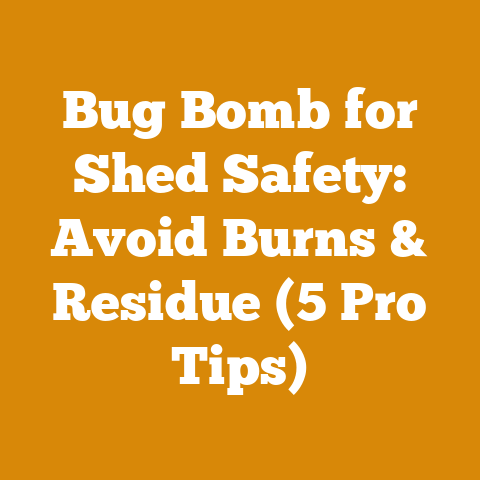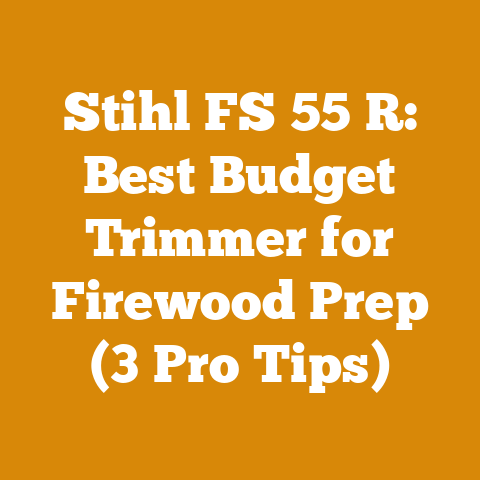Triclopyr vs Glyphosate: Best Woodland Herbicide Choice (Pro Tips)
Alright, let’s dive into the world of woodland herbicides!
It’s funny, isn’t it?
We spend so much time worrying about keeping water out of our wood – waterproofing decks, sealing firewood, and battling rot – that we sometimes forget water is the key to applying some of the most important tools in our woodland management arsenal: herbicides.
I remember one particularly soggy spring trying to get ahead of the invasive honeysuckle choking out a patch of young oaks I was trying to cultivate.
I’d mixed my herbicide, prepped my spray rig, and then… the heavens opened.
I was cursing the rain, of course, but then it hit me: this was perfect!
The rain meant the herbicide would be washed off the foliage and into the soil faster, targeting the roots more efficiently.
Sometimes, Mother Nature gives you a helping hand, even when she seems to be throwing a wrench in your plans.
Today, though, we’re not just talking about water, we’re talking about the stuff we mix with the water: herbicides.
Specifically, we’re going to get into the nitty-gritty of two of the most common (and often debated) options: Triclopyr and Glyphosate.
Which one is best for your woodland?
Well, that’s what we’re here to figure out.
I’ll share some pro tips, personal experiences, and even a few hard-won lessons learned the hard way over the years.
Triclopyr vs. Glyphosate: Best Woodland Herbicide Choice (Pro Tips)
Choosing the right herbicide for your woodland is crucial for maintaining a healthy and productive ecosystem.
It’s not just about killing unwanted plants; it’s about doing so responsibly and effectively, minimizing harm to desirable species and the environment.
Triclopyr and glyphosate are two widely used herbicides, each with its own strengths and weaknesses.
Understanding these differences is key to making informed decisions for your specific needs.
Understanding Your Target: Why Identification Matters
Before we even think about herbicides, let’s talk about identification.
This is where many folks, especially those new to woodland management, stumble.
You can’t effectively fight an enemy if you don’t know what it looks like.
I’ve seen countless situations where well-meaning landowners sprayed everything green in sight, only to discover they’d wiped out a patch of native wildflowers while the invasive buckthorn continued to thrive.
The Critical First Step: Plant Identification
- Know Your Weeds: Accurately identify the invasive or unwanted species you’re targeting.
Is it a woody shrub like honeysuckle or buckthorn?
A broadleaf weed like poison ivy?
A grass? - Know Your Desirables: Equally important, identify the desirable plants you want to protect.
This includes trees, shrubs, wildflowers, and grasses. - Use Resources: Invest in a good field guide for plant identification.
Local extension offices and forestry agencies often offer workshops and resources to help you identify plants in your region.
Online resources like the USDA Plants Database (https://plants.sc.egov.usda.gov/) are invaluable. - Timing is Everything: Plant identification can be easier at certain times of the year, such as during flowering or when leaves have fully emerged.
My “Oops” Moment: I once misidentified a patch of young elderberry saplings as sumac (a notoriously aggressive spreader).
Let’s just say I felt pretty foolish (and guilty) after I’d given them a good dose of herbicide!
It was a valuable lesson: always double-check your identification.
Glyphosate: The Broad-Spectrum Workhorse
Glyphosate, often sold under the brand name Roundup (though many generic versions exist), is a non-selective, systemic herbicide.
This means it kills a wide range of plants and is absorbed through the foliage, traveling down to the roots to kill the entire plant.
How Glyphosate Works
- Mechanism of Action: Glyphosate inhibits an enzyme called EPSPS, which is essential for plant growth.
Without this enzyme, plants can’t produce certain amino acids, leading to their death. - Systemic Action: Because it’s systemic, glyphosate is effective against perennial weeds, which can regrow from their roots if only the foliage is killed.
- Broad Spectrum: It controls a wide variety of annual and perennial grasses, broadleaf weeds, and woody plants.
When to Use Glyphosate
- General Weed Control: Ideal for clearing large areas of mixed vegetation, such as preparing a site for planting trees or creating a food plot.
- Controlling Annual Weeds: Effective against annual weeds before they go to seed.
- Some Perennial Weeds: Can be effective on some perennial weeds, but often requires multiple applications.
- Cut-Stump Treatment: A common method for killing unwanted trees and shrubs, where glyphosate is applied directly to the freshly cut stump.
Glyphosate: Advantages and Disadvantages
Data Point: Glyphosate Resistance
The rise of glyphosate-resistant weeds is a significant concern.
A study by the Weed Science Society of America found that glyphosate resistance has been documented in over 50 weed species worldwide.
This underscores the importance of using glyphosate judiciously and rotating herbicides with different modes of action.
Triclopyr: The Woody Plant Specialist
Triclopyr is a selective, systemic herbicide primarily used for controlling woody plants and broadleaf weeds.
It’s particularly effective against tough-to-kill species like buckthorn, honeysuckle, and poison ivy.
How Triclopyr Works
- Mechanism of Action: Triclopyr mimics the plant hormone auxin, causing uncontrolled growth and ultimately leading to the plant’s death.
- Selective Action: It’s more selective than glyphosate, meaning it’s less likely to harm grasses when used at recommended rates.
- Systemic Action: Like glyphosate, triclopyr is systemic, killing the entire plant.
When to Use Triclopyr
- Woody Plant Control: Ideal for controlling invasive shrubs and trees in woodlands.
- Broadleaf Weed Control: Effective against broadleaf weeds in lawns and pastures.
- Cut-Stump Treatment: Highly effective for preventing resprouting of cut trees and shrubs.
- Basal Bark Treatment: Can be applied to the lower bark of trees to kill them.
Triclopyr: Advantages and Disadvantages
| Feature | Advantages | Disadvantages
The Power of a Good, Old-Fashioned Case Study
Let’s get away from the theory and talk about real-world application.
I want to share a case study from my own experience managing a 40-acre woodlot in central Wisconsin.
This wasn’t some pristine, untouched forest; it was a working landscape that had been logged periodically over the past century.
As a result, it was a mix of native hardwoods (oak, maple, birch) and a heavy understory of invasive species, primarily buckthorn and honeysuckle.
The Challenge:
- Dense Invasive Understory: The buckthorn and honeysuckle were so thick in places that it was difficult to walk through.
They were shading out native seedlings and preventing oak regeneration. - Desirable Tree Species: I wanted to promote the growth of oak and maple, which are valuable timber trees and provide important wildlife habitat.
- Limited Budget: I didn’t have a huge budget for herbicide treatments, so I needed to be efficient and effective.
The Solution:
- Initial Assessment: I started by mapping the areas with the heaviest infestations of buckthorn and honeysuckle.
I also identified the areas with the most potential for oak regeneration. - Herbicide Selection: Based on the species I was targeting, I chose a combination of glyphosate and triclopyr.
I used glyphosate for general weed control in open areas and triclopyr for targeted treatment of buckthorn and honeysuckle. - Application Methods:
- Foliar Spraying: In areas with dense infestations, I used a backpack sprayer to apply herbicide to the foliage of buckthorn and honeysuckle.
- Cut-Stump Treatment: For larger buckthorn and honeysuckle plants, I cut them down and immediately applied herbicide to the freshly cut stump.
This is a highly effective method for preventing resprouting. - Basal Bark Treatment: For some trees, I used basal bark treatment, applying triclopyr mixed with oil to the base of the trunk.
- Timing: I timed my herbicide applications to coincide with the active growing season, when the plants were most susceptible to herbicides.
I also avoided spraying on windy days to prevent drift. - Follow-Up: I monitored the treated areas regularly and retreated any plants that showed signs of resprouting.
The Results:
- Significant Reduction in Invasive Species: After two years of treatment, I saw a dramatic reduction in the density of buckthorn and honeysuckle.
- Improved Oak Regeneration: With the invasive species under control, oak seedlings began to thrive.
- Increased Biodiversity: The removal of invasive species allowed native wildflowers and other plants to reestablish themselves.
Key Takeaways:
- Targeted Approach: By focusing on specific areas and using the right herbicide for the job, I was able to achieve significant results with a limited budget.
- Persistence is Key: Controlling invasive species is an ongoing process.
It requires regular monitoring and follow-up treatments. - Integrated Management: Herbicide use was just one part of an integrated management plan that also included manual removal of invasive plants and promoting the growth of desirable species.
Data Point: Cost-Effectiveness of Cut-Stump Treatment
A study by Purdue University Extension found that cut-stump treatment with triclopyr was significantly more cost-effective than foliar spraying for controlling woody plants in small areas.
The study estimated that cut-stump treatment cost \$0.15 per plant, compared to \$0.50 per plant for foliar spraying.
Application Techniques: Getting the Job Done Right
The effectiveness of any herbicide depends heavily on proper application.
It’s not just about spraying something green; it’s about getting the right amount of herbicide to the right plant at the right time.
Foliar Spraying
- Equipment: Backpack sprayer, ATV sprayer, or tractor-mounted sprayer.
- Technique: Apply herbicide evenly to the foliage of the target plants, wetting the leaves without causing runoff.
- Timing: Apply during the active growing season, when plants are actively photosynthesizing.
Avoid spraying on windy days or when rain is expected. - Pro Tip: Add a surfactant to the herbicide solution to help it stick to the leaves and penetrate the plant’s cuticle.
I often use a non-ionic surfactant at a rate of 1% v/v (volume/volume).
Cut-Stump Treatment
- Equipment: Chainsaw or hand saw, small spray bottle or paintbrush.
- Technique: Cut the tree or shrub close to the ground and immediately apply herbicide to the freshly cut stump, focusing on the outer layer of sapwood.
- Timing: Apply herbicide as soon as possible after cutting the stump, ideally within minutes.
- Pro Tip: In winter, you can still do cut-stump treatments, but you might need to use a higher concentration of herbicide or use an oil-soluble formulation to penetrate the bark.
Basal Bark Treatment
- Equipment: Backpack sprayer or garden sprayer.
- Technique: Apply herbicide mixed with oil to the lower 12-18 inches of the tree trunk, thoroughly wetting the bark.
- Timing: Can be done any time of year, but is most effective during the dormant season.
- Pro Tip: Use a penetrating oil specifically designed for basal bark treatments.
These oils help the herbicide penetrate the bark and reach the vascular system.
Injection
- Equipment: Tree injector tool.
- Technique: Inject herbicide directly into the tree trunk at regular intervals around the circumference.
- Timing: Can be done any time of year, but is most effective during the active growing season.
- Pro Tip: Follow the manufacturer’s instructions for the specific tree injector tool you are using.
Safety First: Protecting Yourself and the Environment
Herbicide use comes with inherent risks, and it’s crucial to prioritize safety to protect yourself, your family, and the environment.
Personal Protective Equipment (PPE)
- Eye Protection: Wear safety glasses or goggles to protect your eyes from herbicide splashes.
- Gloves: Wear chemical-resistant gloves to prevent skin contact.
- Long Sleeves and Pants: Cover your skin to minimize exposure.
- Respirator: In some situations, such as when spraying in enclosed areas, a respirator may be necessary.
Environmental Precautions
- Read the Label: Always read and follow the herbicide label instructions carefully.
- Avoid Drift: Do not spray on windy days or when rain is expected.
- Protect Water Sources: Avoid spraying near streams, ponds, or wells.
- Dispose of Properly: Dispose of empty herbicide containers according to local regulations.
- Consider Non-Chemical Alternatives: Before using herbicides, consider non-chemical alternatives such as manual removal, mulching, or prescribed burning.
My Close Call: A Reminder to Be Vigilant
I once got a face full of herbicide when a hose on my backpack sprayer sprung a leak.
Luckily, I was wearing safety glasses, but I still got a good dose on my skin.
It was a painful reminder of the importance of wearing PPE and regularly inspecting your equipment.
Beyond the Basics: Advanced Tips and Techniques
Once you’ve mastered the basics of herbicide application, you can start exploring more advanced techniques to improve your results.
Herbicide Mixtures
- Tank Mixing: Combining different herbicides in the same tank can broaden the spectrum of control and improve effectiveness.
For example, mixing glyphosate and triclopyr can control both grasses and woody plants. - Synergistic Effects: Some herbicide mixtures can have synergistic effects, meaning that the combination is more effective than either herbicide used alone.
- Consult the Label: Always consult the herbicide labels to ensure that the products are compatible and to determine the correct mixing rates.
Adjuvants
- Surfactants: Help the herbicide stick to the leaves and penetrate the plant’s cuticle.
- Drift Control Agents: Reduce drift by increasing the droplet size of the spray.
- Foam Markers: Help you see where you’ve already sprayed.
- Dyes: Help you identify treated plants.
Timing and Weather Considerations
- Optimal Timing: The best time to apply herbicides depends on the target species and the herbicide being used.
Generally, herbicides are most effective when plants are actively growing. - Temperature: High temperatures can increase the volatility of some herbicides, leading to drift.
- Rainfall: Rain can wash herbicide off the foliage before it has a chance to be absorbed.
Avoid spraying when rain is expected. - Humidity: High humidity can improve herbicide absorption.
Monitoring and Follow-Up
- Regular Monitoring: Monitor treated areas regularly to assess the effectiveness of the herbicide application.
- Retreatment: Retreat any plants that show signs of resprouting.
- Adaptive Management: Adjust your management plan based on the results of your monitoring.
Data Point: The Impact of Timing on Herbicide Effectiveness
A study by the University of Minnesota Extension found that herbicide applications made in the late summer or early fall were significantly more effective at controlling perennial weeds than applications made in the spring.
This is because perennial weeds are translocating nutrients to their roots in the fall, which helps the herbicide reach the entire plant.
The Future of Woodland Herbicide Use
The future of woodland herbicide use is likely to be shaped by several factors, including:
- New Herbicide Technologies: Researchers are constantly developing new herbicides with improved efficacy, selectivity, and environmental profiles.
- Precision Application Techniques: Technologies like drones and GPS-guided sprayers are allowing for more precise herbicide application, reducing off-target damage and minimizing herbicide use.
- Integrated Pest Management (IPM): IPM strategies that combine herbicide use with other control methods, such as manual removal, prescribed burning, and biological control, are becoming increasingly popular.
- Increased Regulation: Regulations governing herbicide use are becoming more stringent, reflecting growing concerns about environmental and health impacts.
My Prediction: A Shift Towards More Targeted and Sustainable Approaches
I believe that the future of woodland herbicide use will be characterized by a shift towards more targeted and sustainable approaches.
This will involve using herbicides more judiciously, combining them with other control methods, and adopting new technologies that minimize environmental impact.
Making the Right Choice for Your Woodland
So, Triclopyr vs.
Glyphosate?
The “best” choice really boils down to your specific situation.
Here’s a quick decision guide:
- Target Species: If you’re primarily dealing with woody plants like buckthorn or honeysuckle, triclopyr is likely the better choice.
If you need broad-spectrum control of grasses and broadleaf weeds, glyphosate may be more appropriate. - Selectivity: If you need to protect grasses, triclopyr is more selective.
If you’re clearing an area completely, glyphosate may be fine. - Application Method: Consider the application method you plan to use.
Cut-stump treatment is highly effective with both herbicides, but triclopyr is often preferred for basal bark treatments. - Environmental Considerations: Be mindful of the potential environmental impacts of each herbicide.
Glyphosate binds tightly to soil, while triclopyr can be more mobile in water. - Cost: Glyphosate is generally less expensive than triclopyr.
- Resistance: Consider the potential for herbicide resistance.
Rotate herbicides with different modes of action to prevent resistance from developing.
Final Thoughts: Stewardship and Responsibility
Ultimately, managing a woodland is about stewardship.
It’s about making informed decisions that promote the long-term health and productivity of the ecosystem.
Herbicide use can be a valuable tool in your toolbox, but it should be used responsibly and with careful consideration of its potential impacts.
Don’t be afraid to experiment, learn from your mistakes (I’ve made plenty!), and adapt your management plan as needed.
And most importantly, always prioritize safety and environmental protection.
Good luck, and happy woodland managing!






